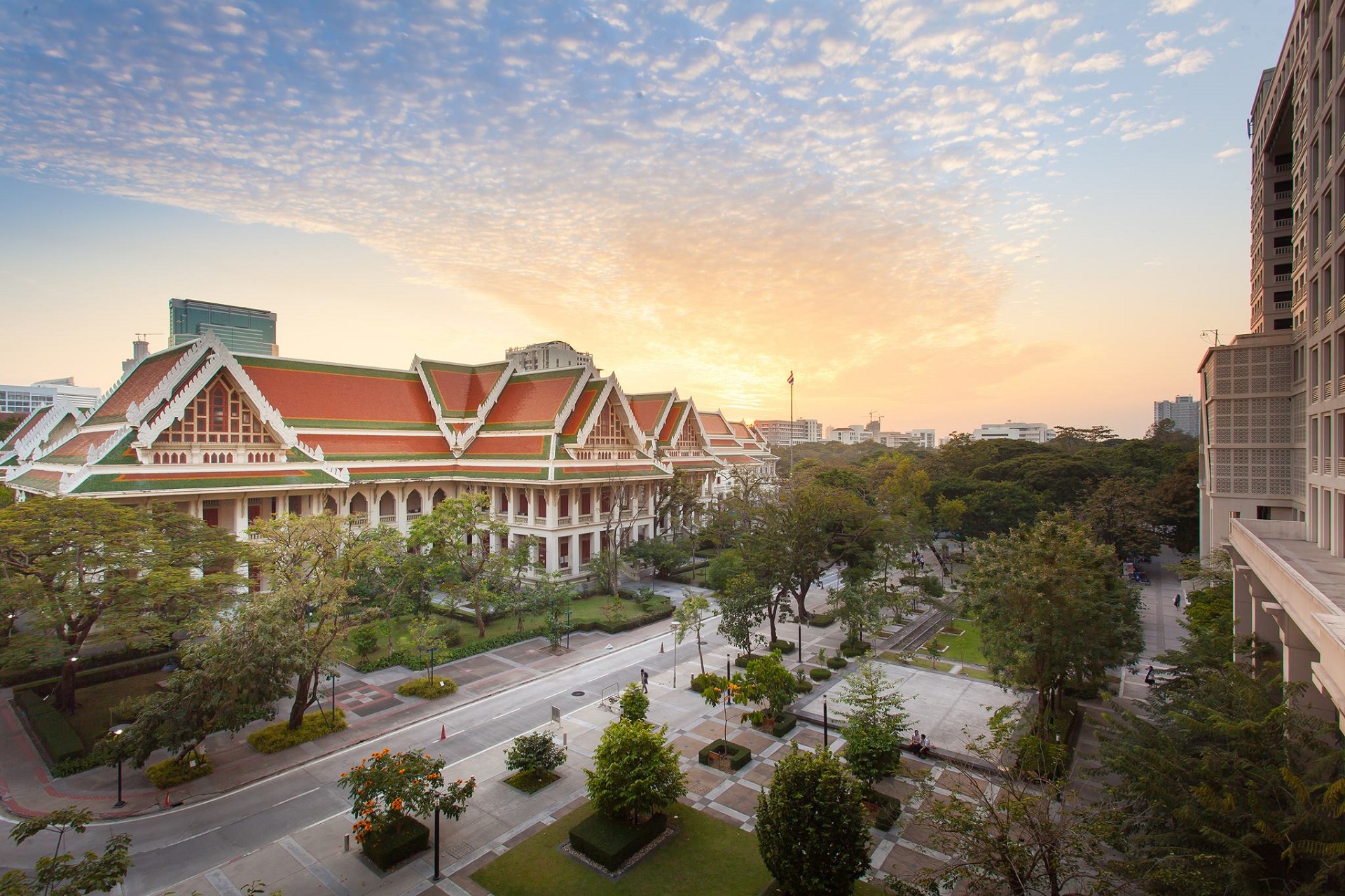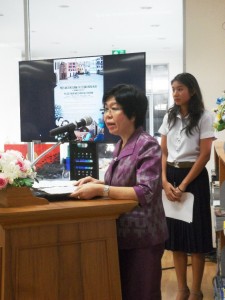
On Thursday, March 17th, 2016, the opening ceremony of “The Good Samaritans of Markowa” exhibition was held at the Learning Commons, Mahachakri Sirindhorn building, Faculty of Arts.
We were honored to have in attendance Associate Professor Dr Kingkarn Thepkanjana, Dean of the Faculty of Arts, and His Excellency Mr Zenon Kuchciak, Ambassador of the Republic of Poland to the Kingdom of Thailand, both of whom gave their welcome remarks.
 It was the perfect timing, so to speak, since that day also marked the official opening of the Ulma Family Museum of Poles Saving Jews in World War II in Markowa, the Republic of Poland. The Ulma family is featured in the “The Good Samaritans of Markowa” exhibition, an exhibition of photographs and documents, some of which came from Josef Ulma’s collection, which tells the story of courageous people in the village of Markowa. Along with other Polish families, the Ulma family rescued and gave shelter to Jews at a time when doing so was punishable by death. Josef and Wiktoria Ulma, their six small children, and the Jews they sheltered were consequently murdered by the Nazi military police on March 24, 1944.
It was the perfect timing, so to speak, since that day also marked the official opening of the Ulma Family Museum of Poles Saving Jews in World War II in Markowa, the Republic of Poland. The Ulma family is featured in the “The Good Samaritans of Markowa” exhibition, an exhibition of photographs and documents, some of which came from Josef Ulma’s collection, which tells the story of courageous people in the village of Markowa. Along with other Polish families, the Ulma family rescued and gave shelter to Jews at a time when doing so was punishable by death. Josef and Wiktoria Ulma, their six small children, and the Jews they sheltered were consequently murdered by the Nazi military police on March 24, 1944.
We felt very honored that the Embassy of the Republic of Poland had entrusted us with this exhibition, which—in the words of Dr. Verita Sriratana—is “a testimony to courage and integrity amidst the atrocities of war, violence, extremism, and inhumane discrimination”.
As part of the opening ceremony, there was a special lecture given by Dr Jolanta Zyndul from the POLIN Museum of the History of Polish Jews, Warsaw. The lecture entitled “Poles and Jews during World War II” was devoted to the relationship between Poles and Jews during that time, focusing not only on the Polish effort to rescue Jews from the grip of the Nazis, but also on the complex and at times contentious relationship between Poles and Jews. There was also a screening of “The Story of Irena Sendler” (2015), a documentary by Andrzej Wolf. Irena Sendler was a Polish nurse and social worker who rescued about 2500 children from the Warsaw ghetto and hid them in the relative safety of Polish families, orphanages, and convents.
The documentary features interviews of Sendler conducted towards the end of her life, wherein she tells the story of how she risked her life rescuing the children imprisoned behind the walls of the Warsaw ghetto, and the lengths to which she had to endure in order to bring them to safety. One cannot even begin to imagine the courage it must have required for people like the Ulma family and Irena Sendler to stand up against the cruel Nazi regime — to be, as Associate Professor Dr Kingkarn remarked, “good and righteous in the worst of times”, risking oneself for others, knowing the consequences. These people deserve to be remembered and honored for their selflessness and bravery, many of whom had to pay the highest price.
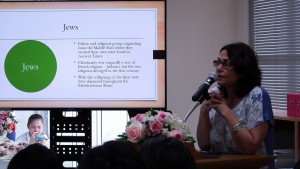 The Holocaust remains a haunting shadow in the history of humanity, and an interesting question was raised by an audience member during the post-lecture discussion: how should the Holocaust be taught to Thai students? It is one of the darkest chapters in human history, and yet we Thais feel so removed from it. This is understandable, as our history was not directly involved with these events, but it is still important that we understand this period in history in order to gain a better understanding of the world, and its people and places. Speaking as a student who might one day become a teacher herself, I was taught the history of the Second World War very simplistically, with a stronger emphasis on memorization than understanding, and frankly, I do not think this is enough. We must have a proper understanding of history and its effect on the present, not just memorizing dates and names. I am fortunate enough to have met professors here at the Faculty of Arts who completely changed the way I understand history, and even though simplifying the Holocaust and its place in world history is necessary when teaching middle- or high-schoolers, I do believe that they are capable of grasping its weight and its effects. It may be possible to teach it in comparison to national history, as Dr Zyndul suggested, but we must not downplay it. This is a part of history we should never sanitize, romanticize, or glorify. By teaching and learning the truth, we can gain a better understanding of the world and make sure this will be the only time such tragedy ever occurred.
The Holocaust remains a haunting shadow in the history of humanity, and an interesting question was raised by an audience member during the post-lecture discussion: how should the Holocaust be taught to Thai students? It is one of the darkest chapters in human history, and yet we Thais feel so removed from it. This is understandable, as our history was not directly involved with these events, but it is still important that we understand this period in history in order to gain a better understanding of the world, and its people and places. Speaking as a student who might one day become a teacher herself, I was taught the history of the Second World War very simplistically, with a stronger emphasis on memorization than understanding, and frankly, I do not think this is enough. We must have a proper understanding of history and its effect on the present, not just memorizing dates and names. I am fortunate enough to have met professors here at the Faculty of Arts who completely changed the way I understand history, and even though simplifying the Holocaust and its place in world history is necessary when teaching middle- or high-schoolers, I do believe that they are capable of grasping its weight and its effects. It may be possible to teach it in comparison to national history, as Dr Zyndul suggested, but we must not downplay it. This is a part of history we should never sanitize, romanticize, or glorify. By teaching and learning the truth, we can gain a better understanding of the world and make sure this will be the only time such tragedy ever occurred.
The memory of the Second World War and the Holocaust is still very much alive and painful today, as one of the cruelest crimes ever committed in human history, and along with it, the legacy of the kind, brave people who risked their own lives to save others, willing to die for a cause deemed they thought was noble and righteous. It is important that we know the past is never dead; it has real and long-lasting effects on the present and the future. History is still with us, not only for scholars and students but for all of humanity, and it is important that we protect it from the passage of time, from ignorance and erasure. If what becomes of the world for our children depends on us, it is even more important that we remember what happened in our past, to remind ourselves that we must find the courage and integrity within ourselves to stand up for what we think is right, and to not allow such crime against humanity to ever be committed again.
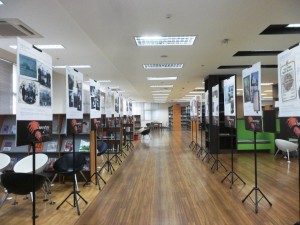 “The Good Samaritans of Markowa” exhibition is organized by the Central and Eastern European Studies Section of the Centre for European Studies at Chulalongkorn University, in collaboration with the Embassy of the Republic of Poland in Bangkok and the Department of History, to whom we express our deepest gratitude. The exhibition will be held at the Learning Commons until Tuesday, April 5th, 2016. We must also thank Dr. Verita Sriratana, Head of the Central and Eastern European Studies Section, whose dedication and hard work made such an event with a great learning opportunity possible.
“The Good Samaritans of Markowa” exhibition is organized by the Central and Eastern European Studies Section of the Centre for European Studies at Chulalongkorn University, in collaboration with the Embassy of the Republic of Poland in Bangkok and the Department of History, to whom we express our deepest gratitude. The exhibition will be held at the Learning Commons until Tuesday, April 5th, 2016. We must also thank Dr. Verita Sriratana, Head of the Central and Eastern European Studies Section, whose dedication and hard work made such an event with a great learning opportunity possible.
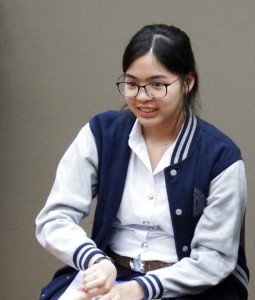
Written by Anna Lawattanatrakul
3rd year student, BALAC Program

